#cornell program board
Text


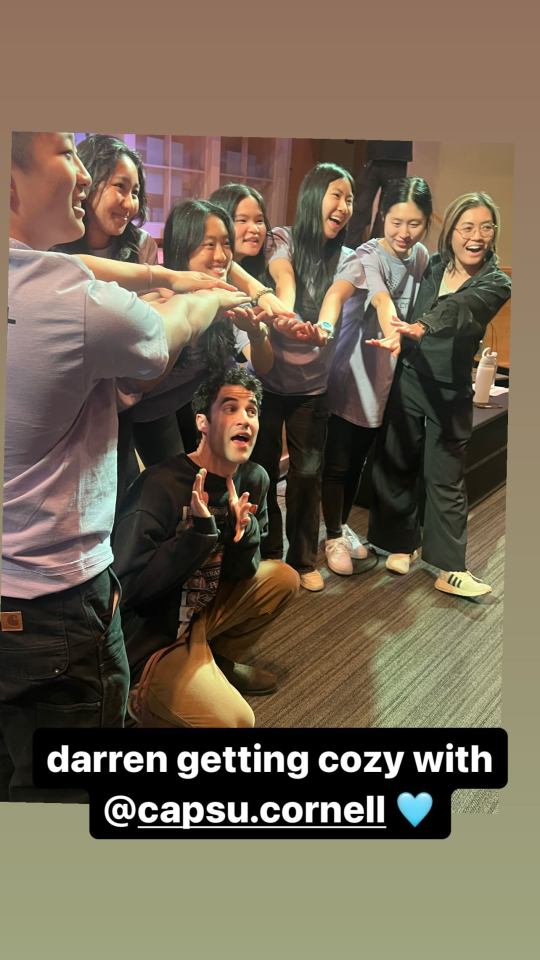
Via Cornell Program Board (CUPB)'s Instagram Story (April 13th, 2024)
#darren criss#cornell program board#cupb & capsu presents an evening with darren criss#instagram#video#april 2024
49 notes
·
View notes
Text

Darren Criss | Cornell University Program Board moderated Q&A | April 13, 2024 | 📸 via Ricky Rollins
Retro Childhood Film Sweatshirt | ♡
(Similar: ♡, ♡, ♡, ♡)
#darren criss#darren style/closet#menfashion#celeb fashion#celeb style#cornell program board#cupb q&a with darren criss#darren x disney
13 notes
·
View notes
Text
There were two central issues at Columbia: the question of divestment and that of university decision-making. The heart of the divestment argument is that money changes things. If economic sanctions against South Africa were pursued with the vigor of, say, the destabilization of the democratically elected government of Allende in Chile, the regime might well be prevented from prosecuting the war in Namibia, and forced into negotiating with the African National Congress. Divestment, as an act of solidarity with the black trade unions and the United Democratic Front in South Africa, can help make South Africa ungovernable. [...] As the Columbia Coalition points out, "IBM is still supplying computers which keep track of blacks under the pass law system, Mobil is still providing oil to the South African military, and all companies are still obliged under the Key Points Act to offer their factories to the military in case of black unrest. " At present, Columbia's investment policy looks more and more like the Reagan administration's "constructive engagement "-which has meant backing IMF loans to South Africa, sending 2,500 electric shock batons to apartheid's police, and encouraging American investment. Indeed the changes that have taken place in South Africa-like the heavily-boycotted "Coloured" and Asian Parliaments-are, as Stanley Greenberg of Yale's Southern Africa Research Program has argued, signs not of the success of "constructive engagement" but of the vulnerability of the apartheid regime.
But the Columbia blockade was not only about divestment: since the University Senate had unanimously voted for full divestment, the blockade focused attention on the unaccountability of the university trustees. In the course of the blockade, two visions of the university came into conflict: on the one hand the humanistic ideal of the university as a community, which, if not quite democratic, still recognizes the rights and responsibilities of its several bodies-faculty, students, staff, alumni; and on the other hand, the reality of the university as a real estate corporation, directed by a corporate board, increasingly dependent on corporate monies, and selling a service to student consumers. Students at Columbia became particularly aware of the second Columbia-Columbia Inc.-when the administration bitterly resisted recognizing the clerical union earlier this school year. They have seen it again in the trustee's resistance to the university community's decision for divestment. And during the blockade, the support from community and tenants groups included an education about Columbia as landlord and gentrifier. The various lived experiences of the corporate university was the ground for the reciprocal support between students and clerical workers, and for the two major marches: one from Harlem to Hamilton Hall, the other from Hamilton Hall to Harlem. As Tanaquil Jones of the Coalition said, "We're going to give back to the Harlem community what they've given us."
[...] The Columbia blockade sparked sit-ins, demonstrations and arrests at cam puses across the country: among them, Berkeley, Rutgers, Purchase, Cornell, Princeton, Santa Cruz, and Syracuse. Though each of these has their own history and internal dynamics, and all of them, including Columbia, are part of a larger history of actions against American support for apartheid, the events of April do provoke the question: "why divestment? " The divestment movement has uniquely condensed the unquestioned opposition to the apartheid regime of the mass of students, a focus on a specifically university issue of investment, and, perhaps most strikingly, the possibility of multiracial action, the prefigurative politics of a rainbow coalition.
Michael Denning, Money Changes Everything: The Divestment Bockade at Columbia Inc. (1985)
64 notes
·
View notes
Text
April recap
What I predicted:
Bluesy's birthday
An Evening with Darren Criss by CUPB Cornell University Program Board
c2e2 Chicago
What we got:
Questlove game night
and that's what you really missed on Glee podcast
An Evening with Darren Criss by CUPB Cornell University Program Board
Suffs opening night
A little more alive (Nick Blaemire)
Scary Pockets
Justice League: Crisis on Infinite Earths – Part Two (totally forgot to put it in my preview)
c2e2
2 notes
·
View notes
Text
Robert M. Wood
was a 43-year employee of Douglas Aircraft, then McDonnell Douglas, and Boeing. Based on his B.S. in aeronautical engineering at the University of Colorado and his Ph.D. in physics from Cornell, he was given challenging technical and management assignments in his career in the aerospace business. He has been active in UFOs since about 1967 when he became involved with Professor James E. McDonald, who tried to get him to testify about the Douglas work going on studying the possibility of gravity control and the relationships to UFOs. He was on the Board of Directors for the Aerial Phenomena Research Organization, and was asked to be the Director of Research for MUFON after he retired in 1993. He has been active in researching the authenticity of various questioned Documents related to a possible covert UFO program, in concert with his business Partner and son Ryan S. Wood.
Ryan & Robert Wood: MJ-12 Documents - Where Do They Lead? (Xcon, 2005)
youtube
Robert M. Wood: Validating the New Majestic Documents (Paper presented at the International MUFON Symposium, St. Louis, MO, July 2000)
Robert Wood: Leaked Government Documents And UFO Crash Retrievals (Exopolitics, 2007)
youtube
Ryan Wood: Majic Eyes Only - Earth's Encounters with Extraterrestial Technology (MUFON, Los Angeles, CA, 2006)
youtube
Monday, November 6, 2023
6 notes
·
View notes
Text

CHARACTER INFORMATION
face claim: Ben Feldman
full name: Adrian Ellis
nickname(s) / goes by: Adi
pronouns & gender: he/him cis man
sexuality: heterosexual
birth date: July, 12, 1984 (39)
birth place: Portland, Maine
arrival to merrock: Moved to town about ten years ago to make his own start away from his parents.
housing: Historical Downtown
occupation: Web developer/designer
work place: Office just out of town and working from home.
family: Younger sister
relationship status: single
PERSONALITY
Adi is an attractive but modest guy, he is optimistic and likes to be helpful to those around him. Although he comes across pretty confident, he is actually rather shy and reserved and talks a lot to cover it. At times, he can be immature, a know-it-all and a little spoilt as he comes from a rich family. But he is caring, gentle and a good friend.
WRITTEN BY: Soph (she/her), gmt.
BACKGROUND / BIO
Adrian who likes to be known as Adi was born in Portland, Maine, though for a long time he considered New York to be his home after moving there when he was just six years old. His parents were both lawyers who had high expectations and worked long hours. Although he didn’t want for much, he didn’t spend too much time with his parents and he was sent to boarding school at a very young age.
Adi has always been incredibly smart and he enjoyed the challenge of boarding school. However, at times he could be a little too smart for his own good and his opinions often got him into trouble. He was known to argue with teachers over something he’d read or a documentary he’d seen, just eager to share what he'd learnt. He excelled throughout school, with most things in life coming pretty easy to him. He read about everything and anything and he liked to show off his wide range of knowledge, telling anyone who would listen and always having something to say about most situations. This is something he still does in adult life, he often corrects people and can come across a little annoying but he means well and he’s a kind natured guy who goes out of his way to help people.
His parents had money and he had plenty of opportunities, he played several instruments and took advanced classes. He even spent his summers helping at the law firm. Though his real passion was computers and gaming. He would spend hours taking apart old machines and messing with a range of software. He was smart and could teach himself how to edit, create programs and code. He enjoyed getting to express himself and finding something for himself.
However, his parents weren’t too happy with his choice to pursue IT and programming at college, they wanted him to become a doctor or lawyer and that only pushed him further away from them. Instead of applying for college, Adi took his trust fund and decided to take a gap year which turned into four years. Many would consider him to be a spoilt rich boy who rebelled against his parents, and maybe in a way he was but Adi was happy. He travelled, he went backpacking and he saw the world for himself. The places he experienced were a big influence on him and brought him out of his shell.
Though at the age of 22, Adi knew he had to make some kind of plans for his future. He had the grades to go to any university that he wanted and he decided to return to New York and applied to Cornell. His parents agreed to help him financially, glad their son was finally going back into education, even if working with computers hadn’t been their first choice for him. Though he thrived, he enjoyed the hard work and learning new things and being able to put his arguments and opinion into what he loved. He grew in confidence and made a best friend who encouraged him to be him. They're still friends today.
After university, Adi worked for a tech company in New York for a few years and completed his Masters degree. However, it always felt like something was missing. The job paid well and he didn't hate it but he felt like he wasn’t really moving forward. Growing up, he'd enjoyed visiting his grandparents in Maine. It was relaxed there, they left him to do his own thing. He'd spend hours reading outside and playing video games all day. His sister had moved to Maine in her teens after being kicked out of private school. She'd attended high school in Merrock and about ten years ago, Adi decided it was time for him to settle there too and to move away from their parents.
He lives in a nice home in Merrock and works for a company not far from the town. He's still a little dork at time but he is rather confident in who he is and hoping one day he'll find the right person to be in that life with him.
2 notes
·
View notes
Text
Labor Organizer Spotlight, Mabel Fuller! ⭐
This week's #LaborOrganizerSpotlight is Mabel Durham Fuller!
Mabel Durham Fuller was born on April 1, 1905 in Kingston, New York, where she attended the local public schools of Kingston and Yonkers. She was an operator in an undergarment factory before the shop was unionized, and after it was organized, Fuller became the shop chairlady. She was a member of the Undergarment and Negligee Workers Union, Local 62 and elected to the Executive Board in 1937. As a member of the Board, Fuller served on the Finance Committee and Sick Benefit Committee. She was also elected as a delegate to attend several ILGWU National Conventions. Fuller attended the Hudson Shore Labor School, as well as the U.S. Army Administration school from 1944-1945, and was the first woman to attend the Harvard Trade Union Institute where she was a fellow from 1945-1946. Fuller became the first African American staff member of the Education Department in 1946. In the Education Department, Fuller helped to plan and direct programs that aimed at improving the image of the union not only to the members, but also to the public.
Fuller was an American National Red Cross instructor, chair of the Women's Service Brigade during World War II, delegate to the Negro Labor Committee, member of the Committee for Civil Rights, the Urban League, the NAACP, and the Liberal Party.
More about Mabel Durham Fuller can be found in Coll. 6036/034.
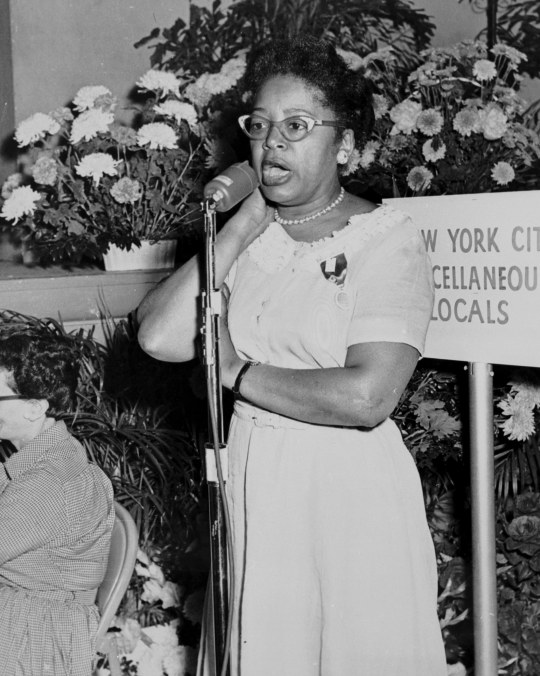
Mabel Fuller, assistant educational director of ILGWU Local 62, giving a speech.
#ILGWU #InternationalLadiesGarmentWorkersUnion #NAACP #MabelFuller #Harvard #LaborOrganizer #UnionStrong #Unions #May #Cornell #LaborArchives #LaborHistory #ArchivesOfInstagram #AllLaborHasDignity #KheelCenter #ILRSchool #LaborRights #Strikes #LaborOrganizerSpotlight @CornellILR @CornellTextileIndustry @CornellFashionCollection
2 notes
·
View notes
Photo
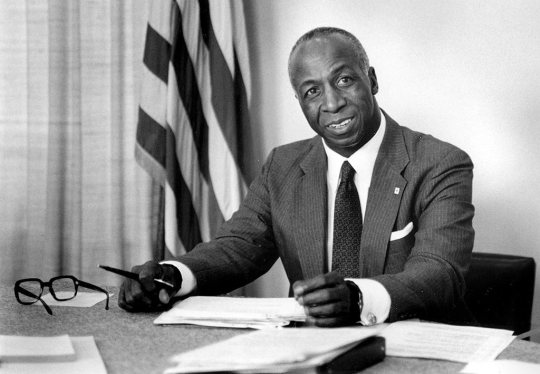
Jerome Heartwell "Brud" Holland (January 9, 1916 – January 13, 1985), in Auburn, New York. The parents of Holland, and his twelve other siblings, were Robert Holland, a gardener/carpenter, and Viola Bagby Holland. He attended Auburn High School, where he began playing football. He was accepted to Cornell University and became the first African American to play for the school’s football team. He was an All-American athlete at Cornell for two consecutive years. Upon graduation, he entered Cornell’s graduate program and earned an MA in sociology. He was hired by Lincoln University, where he taught sociology and physical education. He married Madeline Smalls (1941-1944) and the couple had two children before. He went to work for Sun Shipbuilding and Drydock Company of Pennsylvania where because of wartime demand for labor, he earned considerably more than his teacher’s salary at Lincoln University. He married Laura Mitchell (1948-1985) and had two more children. He earned his Ph.D. from the University of Pennsylvania. He was named President of Delaware State College serving from 1953 to 1959. In 1960 he became President of Hampton Institute, where he remained for a decade. President Richard Nixon named him the Ambassador to Sweden, a post he held until 1972. This was a rare appointment. He was only the second African American assigned as ambassador to a European nation. He occupied a series of influential positions in such corporations as AT&T and General Foods. He became the first African American to serve on the board of directors for the New York Stock Exchange. He became a member of the American Red Cross’s Board of Governors. He served on the non-profit’s board from 1964 to 1970 and from 1977 until his death. He was a member of the Sigma Pi Phi fraternity. He was awarded the Presidential Medal of Freedom by President Ronald Reagan posthumously. #africanhistory365 #africanexcellence #sigmapiphi https://www.instagram.com/p/CnMd8Klrr0P/?igshid=NGJjMDIxMWI=
2 notes
·
View notes
Text

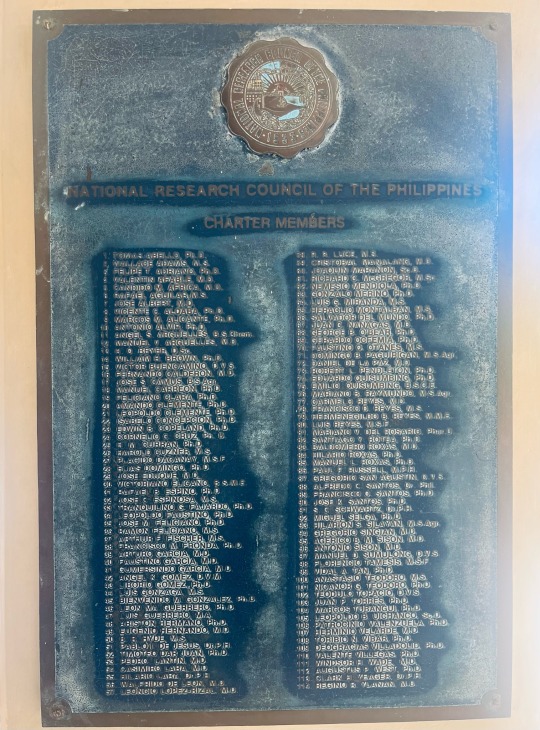
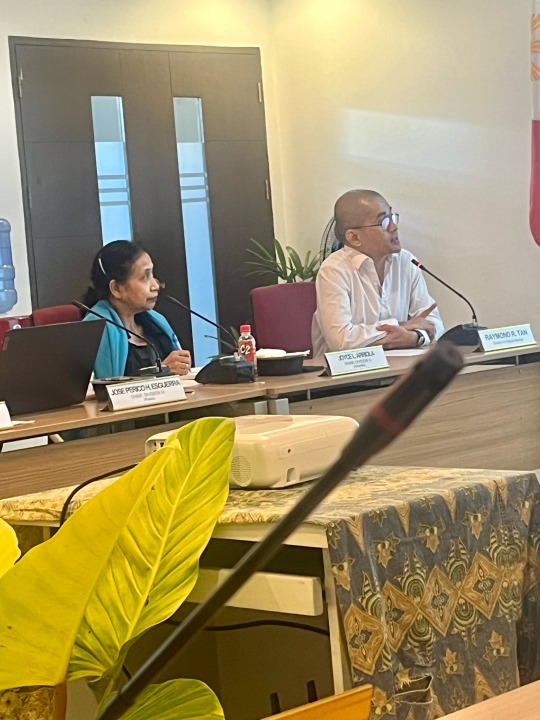
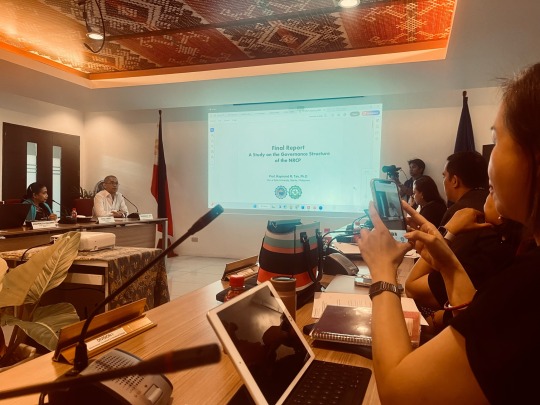
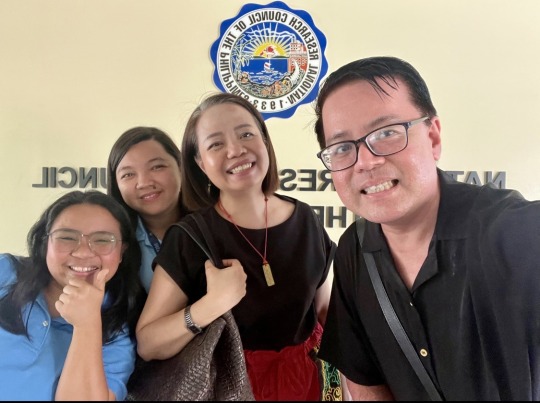

At the 1,090th Regular Meeting of the DOST-National Research Council of the Philippines (NRCP) Governing Board on 30 April 2024. Entomologist and former UP Faculty Regent Dr. Aimee Lynne Barrion-Dupo is the new President. DOST-NRCP was established through Act No. 4120 of the 9th Philippine Legislature on December 8, 1933, to advance research in the various disciplines.
DOST-NRCP's charter members in 1933 include Victor Buencamino (the 1st Filipino to earn a Doctor of Veterinary Medicine degree at Cornell, the 1st Filipino President of the Philippine Veterinary Medical Association and the 1st Filipino to establish a veterinary hospital in the Philippines), anthropologist H. Otley Beyer, obstetrician Fernando Calderon (the 1st Filipino UP College of Medicine Dean and the first Filipino UP PGH Director), UPLB pioneering professors Edwin Copeland (botany) and Harold Cuzner (agronomy), National Scientist Francisco Fronda (Father of Poultry in the Philippines and Thailand), UP President Bienvenido Gonzalez (1939-1954; 1945-1951), botanist Leon Ma. Guerrero (the 1st licensed Filipino pharmacist), botanist Eduardo Quisumbing (whose “Medicinal Plants in the Philippines” is the forerunner of all research on medicinal plants in the country), former FEU President and UE co-founder Hermenigildo Reyes, iconic UP College of Medicine Deans Antonio M. Sison (1937-1951) and Agerico B.M. Sison (1951-1960), forester Florencio Tamesis (the Father of Philippine Forestry), UP President Vidal Tan (1951-1956), UP Pharmacy Dean Patrocinio Valenzuela, and 4-time Far Eastern Games gold medalist for athletics Regino Ylanan (later, he became a physician, a 1928 Amsterdam Olympics coach, and the first Filipino to graduate with a sports science degree from the United States. At age 30, he was appointed UP's physical education director. He also founded the NCAA and headed the Philippine delegation to the 1936 Berlin Olympics).
Subsequently, Republic Act No. 2067, known as the Science Act of 1958 and enacted on June 13, 1958, led to the creation of the National Science Development Board (NSDB). Section 20 of this Act designated the DOST-NRCP as the official advisor on scientific matters to the Government of the Philippines.
Executive Order No. 784, issued on March 17, 1982, restructured the National Science Development Board into the National Science and Technology Authority (NSTA). In this new framework, the DOST-NRCP was identified as one of the science and technology councils under the Authority for coordinating policies and programs.
Under Executive Order No. 128, dated January 30, 1987, the NSTA underwent further reorganization, renaming the NRCP as the Philippine National Science Society (PNSS).
However, the agency's name was eventually restored to the National Research Council of the Philippines through Republic Act No. 6974 on December 8, 1990.
The DOST-NRCP's mandate includes promoting and supporting fundamental research to enhance the capabilities of researchers and research groups, offering advice on national issues, fostering a culture of research across sectors, and establishing partnerships with local and international institutions for collaboration in information development and sharing.
0 notes
Text
Ozempic Alternatives: Three Options For Weight Loss, According To Experts
— By Rena Goldman | Forbes

Our editorial content is based on thorough research and guidance from the Forbes Health Advisory Board. Getty Creative
Ozempic is exclusively approved by the Food and Drug Administration (FDA) as a medication to treat type 2 diabetes, but semaglutide (its active ingredient) has become increasingly popular for its ability to boost weight loss. Even though Ozempic shows promise as a weight loss medication, it might not be for everyone; the medication isn’t safe for people with certain conditions, it can be pricey and there are side effects and supply concerns to consider.
Depending on your health history, preferences, the medication’s cost and availability and your treatment needs, you might want to consider different options. In this article, we explore some alternatives to Ozempic for weight loss.
What Is Ozempic?
Ozempic is an FDA-approved medication for treating type 2 diabetes. Its active ingredient is semaglutide, a glucagon-like peptide-1 (GLP-1) receptor agonist that acts like the GLP-1 hormone released in the digestive tract when eating. This weight-regulating hormone “signals fullness to the brain, delays stomach emptying and lowers blood sugar,” says Rekha Kumar, chief medical officer at the medically-assisted weight loss program, Found, and practicing endocrinologist in New York City.
The medication is available by prescription only and is used as a weekly injection to help with blood sugar management and help reduce the risk of a heart attack or stroke in people with type 2 diabetes. Since semaglutide has shown effectiveness in reducing body weight for those with overweight or obesity, Ozempic may also aid in weight loss. However, Ozempic itself is not FDA approved to treat weight loss alone in patients without a diagnosis of type 2 diabetes.
Ozempic Alternatives For Weight Loss: Similar Medications
Many people with obesity have a difficult time losing a significant amount of weight and keeping it off with lifestyle changes alone, notes Katherine H. Saunders, M.D., co-founder of Intellihealth, an obesity treatment company, and clinical assistant professor of Medicine at Weill Cornell Medicine in New York. This is where medication can come into play.
“Some [weight loss] medications are better for hunger, some are better for cravings, and some are great for both,” says Dr. Saunders. She stresses the importance of selecting an anti-obesity medication based on a personalized treatment plan. “Obesity is not a simple disease, and there’s no one medication that’s right for everyone.”
While Ozempic isn’t FDA-approved for weight loss, Wegovy and Saxenda—two weight loss medications that are also GLP-1 agonists—are.
“Just like Ozempic, Wegovy and other GLP-1 agonists are the most effective weight loss medications that currently exist,” says Raoul Manalac, M.D., the senior director of clinical experience at Ro, a company offering at-home medical treatment.
The list price (according to Novo Nordisk, the manufacturer of Ozempic and Wegovy) of Ozempic is $935.77. However, the manufacturer notes that most people don’t pay list price when the drug is covered by insurance.
By comparison, Novo Nordisk lists Wegovy at $1,349.02 per package. The company also notes that when health insurance covers weight-management medications, people don’t pay list price. Saxenda, which is also made by Novo Nordisk, is listed at $349.02.
What an individual ends up paying will depend on their insurance coverage for anti-obesity medications.
Wegovy
Wegovy is another injectable medication made with semaglutide (the active ingredient in Ozempic). It’s approved by the FDA for weight management in people with a body mass index or BMI of 27 who have another weight-related condition, such as type 2 diabetes, or those with a BMI of 30 or higher. In recent research, semaglutide showed a higher effectiveness for weight loss than older medications, with the potential for a 15% weight loss after 68 weeks in adults with a BMI of 30 or greater[1].
Like Ozempic, it’s also prescription only and taken once a week. The main difference between the two, notes Dr. Saunders, is in the instructions for increasing the dose and the highest dose given.
Saxenda
Saxenda, like Ozempic and Wegovy, is a GLP-1 receptor agonist, but it’s made with liraglutide (instead of semaglutide). The medication is also prescription-only and FDA-approved for the treatment of obesity in people aged 12 and older who weigh more than 132 pounds or adults with BMI of 30 or higher. While liraglutide may be slightly less effective than semaglutide, it’s still a potent weight loss medication that could lead to up to an 8% weight loss, says Dr. Manalac.
Liraglutide works by helping to decrease appetite and slow the emptying of the stomach, which causes feelings of fullness and leads to lower calorie intake.
Saxenda is a daily injection, while Ozempic and Wegovy are weekly injections.
Ozempic Alternatives For Weight Loss: Natural Solutions
Weight loss medications can be effective, but many people gain the weight back after stopping them. They may also not be covered under insurance or Medicaid in many states. Those who are not able to access or use weight loss medications may choose to focus on natural solutions, such as dietary changes and exercise.
Even if you do use weight loss medications, they’ll still need to be paired with dietary changes and regular physical activity for the best results. In fact, the FDA notes in its approval of Saxenda for weight management in individuals ages 12 and older that the medication is an additive to a reduced calorie diet and increased physical activity.
If you’re not sure how to start changing your diet or making physical activity part of your weekly routine, healthcare providers can help. Dietitians and nutritionists can provide personalized counseling to help you plan meals and make lasting changes to your eating habits. A healthcare provider can also help you get started on an exercise routine that’s safe for you.
Dietary Changes
In order to achieve and maintain weight loss in the long term, the changes you make should be habits you can keep, rather than following the latest diet fad. In fact, recent research concludes there’s no one best weight loss strategy. and that healthcare providers should consider a person’s personal preferences when helping them come up with a plan[3].
However, there are general recommendations for dietary changes that can help with weight loss.
Dr. Kumar recommends increasing protein intake because eating protein reduces hunger. “To maximize muscle preservation during active weight loss, people should focus on consuming 25 to 30 grams of protein per meal,” she says. Some easy ways to get extra protein in your diet include using low-fat Greek yogurt or cottage cheese as part of a snack or in place of sour cream, adding beans to salads and using quinoa instead of rice or pasta, adds Dr. Kumar.
People should consider making dietary changes by avoiding ultra-processed foods, added sugars, fast food and sugar-sweetened drinks, advises Dr. Saunders. Ultra-processed foods include potato chips, lunch meats, white bread and anything that must be heavily processed to make. These foods have ingredients like high-fructose corn syrup, artificial flavors and hydrogenated oils. Research suggests that ultra-processed foods are linked to weight gain.
Another behavior change Dr. Saunders encourages people to make is to consume most of their calories during the day and try to make dinner a smaller, earlier meal. “Research shows that eating late decreases calories burned, increases calories stored as fat and leads to more hunger in general,” she explains.
Physical Activity
Physical activity has a number of physical and mental health benefits, including reducing the risk of type 2 diabetes, high blood pressure and osteoporosis, and improving the quality of sleep. It’s also an important part of losing weight and maintaining a healthy weight. The Centers for Disease Control and Prevention (CDC) recommends at least 150-300 minutes of moderate-intensity aerobic activity each week.
Examples of moderate activity include walking and biking, while high-intensity activities may include running, swimming laps or jumping rope.
In order to lose weight or maintain weight loss, you’ll need to pair regular physical activity with dietary changes.
Over-The-Counter Ozempic Alternatives: Why You Should Avoid Them
The semaglutide weight loss medications Ozempic and Wegovy are available by prescription only, and there are no FDA-approved generic versions. This means only the pharmaceutical company that makes them can produce the FDA-approved drugs.
“Unauthorized semaglutide (Ozempic) alternatives that pharmacies are offering are called compounded semaglutide,” explains Dr. Kumar. “Compounded medications are not FDA-approved or vetted, and are custom-made by combining, mixing or altering ingredients to create a medication tailored for a specific patient, including the combining of two or more drugs.”
The FDA warns consumers about drug compounding and recommends that people avoid them because they aren’t regulated.
“We have no idea what the products contain, what the actual dose of the active ingredient is or whether the product has contaminants,” notes Dr. Saunders.
Whether Ozempic or an alternative medication is right for you will come down to your personal health history. Speaking with your doctor is the best way to figure out which weight loss method will work best.
#Forbes#Forbes.Com#Forbes Heath#Ozempic#Options For Weight Loss#Ozempic | Alternatives#Wegovy | Sexenda#Weight Loss | Natural Solutions#Dietary Changes#Physical Activity#OTC Ozempic | Alternatives | Avoid
0 notes
Text


Via Cornell Program Board (CUPB)'s Instagram Story (April 13th, 2024)
#darren criss#cornell program board#cupb & capsu presents an evening with darren criss#instagram#video#april 2024
43 notes
·
View notes
Text
The New Formalist: Edward Durell Stone
This is the second part of a two-part post. Read part one.
Stone’s Academic Career
During the late 1940s into the early 1950s Stone was an “associate professor of architecture at the Yale University School of Architecture” (2). His reputation allowed him to connect with other prominent architects in academia such as Walter Gropius at Harvard University’s Graduate School of Design, and Pietro Belluschi, dean of MIT’s School of Architecture and Planning. He also guest lectured on architecture at Cornell, Princeton, and Stanford. (2)
A New Woman Brings a New Influence to Edward Durell Stone’s Life
Edward Durell Stone and his first wife, Sarah, divorced in 1952. After his divorce, while on a transatlantic flight, Stone found himself seated next to “Maria Elena Torchio, a fashion writer… and proposed to her before the plane landed” (1). The couple were married in 1954 and “would have two children, Benjamin Hicks Stone III and Maria Francesca Stone” (2).
Stone’s Pivotal Commission in India
In 1954 Stone’s firm was commissioned by the United States government to design a new embassy in New Delhi, India. Stone strived to create a “modern structure that would respect the architectural traditions of its host country” (2). The embassy would define a major shift in Stone’s style which would become known as “New Formalism.” The most prominent feature of the clean, elegant building is its decorative concrete grille. Stone’s hero Frank Lloyd Wright who rarely praised the work of other architects, publicly lauded it (2,4).

Edward Durell Stone, United States Embassy (1954), New Delhi, India. Image source.
Architecture critic Paul Goldberger called it “one of the best‐known pieces of American architecture of the decade” (1). The success of the United States Embassy in New Dehli established Stone’s place as a major American Twentieth Century architect. It also led to important commissions such as the “John F. Kennedy Center for the Performing Arts in Washington, … the General Motors Building in New York, and the State University of New York campus at Albany” (1). “Business Week called him ‘the man with a billion on the drawing board’ ”(3).
“These designs fused the formalism of Stone's early Beaux-Arts training with a romantic historicism, … influenced, in part, by Maria Stone's Italian origins” (2). The couple took several trips to Italy during this time which “reawakened his interest in the classical and Italianate” (2) architecture. While Stone did not intend that his work copy classical architecture he hoped that his work would embody its timelessness. (2)

Edward Durell Stone, Koff Apartments (1965), Deerfield Beach, FL. Image source.
Stone becomes a Celebrity Architect
Edward Durell Stone’s work garnered him publicity both at home and internationally. In 1958 Time did a cover story on the architect. He appeared on many television programs, including Edward R. Murrow’s “See It Now.” Stone published his autobiography, The Evolution of an Architect in 1962. (5)
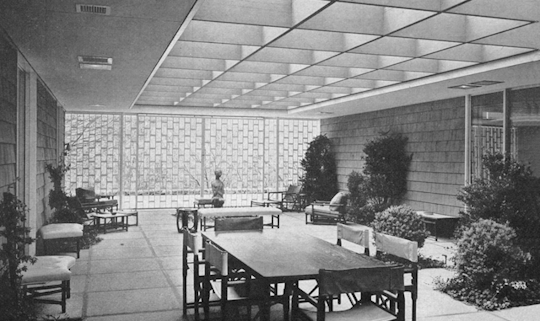
Edward Durell Stone, Carlo M. Paterno House, aka The Atrium House (1962), demolished around 2010. Image source.
Huntington Hartford Gallery of Modern Art
Stone’s later work “became more romantic and more highly embellished” (1), such as the Huntington Hartford Gallery of Modern Art built on Columbus Circle in New York City in 1964.
Paul Goldberger described the building as “an eccentric marble box on delicate legs with arches at top and bottom and characteristic Stone grill work tracery up and down the sides.” The structure's delicate legs caused many New Yorkers to refer to it as “The Lollipop Building.” In the mid-2000s the structure would become embroiled in a controversy over preservation.
“New York City's Landmarks Preservation Commission refused to consider its eligibility for landmark status” (2). Little of Stone’s original design remains after its renovation designed by architect Brad Cloepfil. (7)

Edward Durell Stone, Huntington Hartford Gallery of Modern Art - Two Columbus Circle (1964). Image source.
Edward Durell Stone’s Later Work
Stone’s firm continued to “garner major architectural commissions”, and his later work includes, “the Standard Oil building in Chicago, Illinois (completed 1973); the First Bank Tower in Toronto, Ontario (completed 1975); and the Florida State Capitol in Tallahassee (completed 1978)” (2). His last residential work was the Sheldon Cohen House (1976) in Greenwich, CT. (3) Although successful, these later works earned more scorn than praise from the critics.

Edward Durell Stone, First Bank Tower (1975), Toronto, Canada. Photo credit: Arild Vagen. Image source.
In 1966 Stone and his muse, Maria Elena Torch, divorced. He remarried in 1972, this time to his executive assistant, Violet Campbell La Stella. The couple had a daughter, Fiona Campbell Stone…. Declining health forced Stone to retire from active practice in 1974.” (2) His firm Edward Durell Stone & Associates, however, remained in business until 1993.
Stone’s Tributes and Legacy
During his career Stone had several honorary degrees bestowed on him including one from the University of Arkansas in 1951. (4). Stone received numerous awards for his work including the Medal of Honor from the New York Chapter of the American Institute of Architects in 1955. He became a Fellow of the American Institute of Architects in 1958 (2). He won the Horatio Alger Award in 1971. (4) The Mullins Library at the University of Arkansas holds “an extensive collection of project and personal photographs in addition to a collection of architectural drawings and papers” (2).
Edward Durrell Stone died after a brief illness in New York City on August 6, 1978. (1) His career spanned five decades and encompassed Art Deco, the influence of Frank Lloyd Wright, Modernism, and his own unique decorative style of architecture, reacting against the cold International Style. As Paul Goldberger wrote, “Mr. Stone sought not to go beyond the International Style but to turn the clock back to a personal kind of modern architecture.”
References
Goldberger, P., (7 August, 1978). Edward Durell Stone Dead at 76; Designed Major Works Worldwide. https://www.nytimes.com/1978/08/07/archives/edward-durell-stone-dead-at-76-designed-major-works-worldwide-a.html
R. L. Skolmen and H. Stone, (n.d.). Edward Durell Stone: Life. https://www.edwarddurellstone.org/
Smart, G., (2024). Edward Durell Stone, FAIA (1902-1978). https://usmodernist.org/stone.htm
Wikipedia.com, (7 February, 2014). Edward Durell Stone. https://en.wikipedia.org/wiki/Edward_Durell_Stone
Edward Durell Stone, The Evolution of an Architect, (New York: Horizon Press, 1962), 92.
Britannica.com, (n.d). Edward Durell Stone, American architect. https://www.britannica.com/biography/Edward-Durell-Stone#ref81069
Goldberger, P. (18 August, 2008). Hello, Columbus. https://www.newyorker.com/magazine/2008/08/25/hello-columbus
1 note
·
View note
Text

CHARACTER INFORMATION
Full name: Adrian Charles Ellis
Nickname: Adi
Pronouns and gender: he/him, cis man
Age: 40
Birth place: Chicago (grew up in New York)
Length of stay in Thistlefield: Four years (visited grandparents as a child)
Occupation: Web designer/developer and owns a tech company.
Work place: Office just out of town and working from home.
Family: Younger sister (WC)
Three personality traits: Optimistic, know-it-all, caring
PERSONALITY
Adi is an attractive but modest guy, he is optimistic and likes to be helpful to those around him. Although he comes across pretty confident, he is actually rather shy and reserved and talks a lot to cover it. At times, he can be immature, a know-it-all and a little spoilt because of his wealthy upbringing. But he is caring, gentle and a good friend.
BIOGRAPHY
Adrian who likes to be known as Adi was born in Chicago, though for a long time he considered New York to be his home after moving there when he was just six years old. His parents were both lawyers who had high expectations and worked long hours. Although he didn’t want for much, he didn’t spend too much time with his parents and he was sent to boarding school at a very young age.
Adi has always been incredibly smart and he enjoyed the challenge of boarding school. However, at times he could be a little too smart for his own good and his opinions often got him into trouble. He was known to argue with teachers over something he’d read or a documentary he’d seen, just eager to share what he’d learnt. He excelled throughout school, with most things in life coming pretty easy to him. He read about everything and anything and he liked to show off his wide range of knowledge, telling anyone who would listen and always having something to say about most situations. This is something he still does in adult life, he often corrects people and can come across a little annoying but he means well and he’s a kind natured guy who goes out of his way to help people.
His parents had money and he had plenty of opportunities, he played several instruments and took advanced classes. He even spent his summers helping at the law firm. Though his real passion was computers and gaming. He would spend hours taking apart old machines and playing around with a range of software. He was smart and could teach himself how to edit, creating programs and code. He enjoyed getting to express himself and finding something he was good at for himself.
However, his parents weren’t too happy with his choice to pursue IT and programming at college, they wanted him to become a doctor or lawyer and that only pushed him further away from them. Instead of applying for college, Adi took his trust fund and decided to take a gap year which turned into four years. Many would consider him to be a spoilt rich boy who rebelled against his parents, and maybe in a way he was but Adi was happy. He travelled, he went backpacking and he saw the world for himself as a young man. The places he experienced were a big influence on him and it brought him out of his shell.
Though at the age of 22, Adi knew he had to make some kind of plans for his future. He had the grades and experience to go to any university that he wanted and he decided to return to New York and applied to Cornell. His parents agreed to help him financially, glad their son was finally going back into education, even if working with computers hadn’t been their first choice for him. Though he thrived, he enjoyed the hard work and learning new things and being able to put his arguments and opinion into what he loved. He grew in confidence and made a best friend who encouraged him to be him. They’re still friends today.
After university, Adi worked for a tech company in New York for a few years and completed his Masters degree. However, it always felt like something was missing. The job paid well and he didn’t hate it but he felt like he wasn’t really moving forward. Growing up, he’d enjoyed visiting his grandparents in Scotland. It was relaxed there, they left him to do his own thing. He’d spend hours reading outside and playing video games all day. His sister had moved to Scotland in her teens after being kicked out of private school and attended high school in Thistlefield. Almost five years ago, Adi decided it was time for him to settle there too and to move away from his parents. Taking his trust fund, he bought a company and he is doing what he loves.
He lives in a nice home in Thistlefield and his tech company is a small commute from the town. He’s still a little dork at times but he is rather confident in who he is and hoping one day he’ll find the right person to share his life with him.
1 note
·
View note
Text
CYCLONE V's Role in Advancing String Generation

The group made use of the Kaplus-Strong string synthesis approach to develop a triad of four-stringed tools to be played by the Cyclone V FPGA. A C program working on the advancement board's ARM 9 HPS acts as a song sequencer, managing pace as well as informing the FPGA which to keep in mind to play.
The trainees produced variations of 4 tunes, consisting of "Color Styles of the Wind" from the Pocahontas soundtrack, "Far Above Cayuga's Seas" (Cornell's University) as well as John Tale's "Every One of Me". A basic GUI enables the customer to choose a tune as well as to select which tool or tools to play, offering several variants for every tune.
youtube
1 note
·
View note
Text
April preview
Bluesy's birthday
An Evening with Darren Criss by CUPB Cornell University Program Board
c2e2 Chicago
1 note
·
View note
Text

NASA scientific balloons take to the sky in New Mexico
NASA's Scientific Balloon Program will take flight with eight planned launches from the agency's balloon launch facility in Fort Sumner, New Mexico, flying scientific experiments to a near-space environment via a football-stadium-sized NASA balloon.
The 2023 fall balloon campaign window opens August 10 and features 24 payloads led by teams of scientists, engineers, and students.
"Our annual Fort Sumner campaign is always our most ambitious and packed with cutting-edge science developed from teams here in the United States and around the world," said Debbie Fairbrother, Scientific Balloon Program chief at NASA's Wallops Flight Facility in Virginia.
One mission on deck is the Exoplanet Climate Infrared Telescope (EXCITE). The mission features a suborbital astronomical telescope developed to study Jupiter-type exoplanets orbiting other stars. After this fall's engineering test flight, a flight on a long-duration super pressure balloon is planned.
The EXCITE mission team is composed of members from NASA's Goddard Space Flight Center, Arizona State University, Brown University, Cornell University, University of Oxford, University of Rome, StarSpec Technologies, Inc., University of Toronto, and University College London.
Some additional missions set to fly during the fall campaign include:
Gamma-Ray Polarimeter Experiment (GRAPE): Instrument will measure the Crab nebula to demonstrate imaging and polarization of gamma-ray bursts.
Jet Propulsion Laboratory (JPL) REMOTE: Instruments will address science issues in NASA's Atmospheric Composition focus area, including providing validations data for NASA satellites.
Faint Intergalactic-medium Redshifted Emission Balloon (FIREBall-2): The mission features an ultraviolet multi-object spectrograph designed to detect faint emission from the circumgalactic medium of nearby galaxies.
High-Altitude Student Platform (HASP): This platform assists in training the next generation of aerospace scientists and engineers. On board experiments include an Ozone detection system and an electron spectrometer telescope. A flight test of experimental hardware for larger future experiments will be conducted.
Testbed for High-Acuity Imaging and Stable Photometry and Image-Motion Compensation (THAI-SPICE): The goal of this project is to build and demonstrate a fine-pointing system for stratospheric payloads with balloon-borne telescopes.
Thermalized Neutron Measurement Experiment (TinMan): This mission features a 60-pound payload designed to address concerns about thermal neutron effects on avionics.
Sixteen smaller payloads, called piggyback missions, will ride along during the launches as a valuable and efficient means of supporting additional science and technology development. One of these missions, ComPair, is a Goddard instrument that will test new technologies for studying gamma rays.
Scientific balloons are a quick and cost-effective way to test, track, and recover scientific experiments for NASA and universities from all over the world. Zero Pressure Balloons, used in the upcoming fall campaign, feature open ducts that allow gas to escape and prevent an increase in pressure from inside the balloon. Gas expansion occurs as it heats during the balloon's rise above Earth's surface. These balloons typically have a shorter flight duration due to the loss of gas from the cycle of day to night.
IMAGE....A scientific balloon for the fall campaign is inflated before it will be released for flight. Credit: NASA's Wallops Flight Facility
0 notes